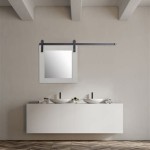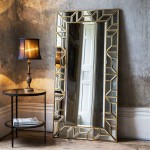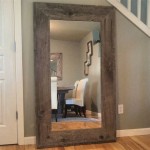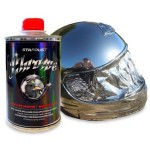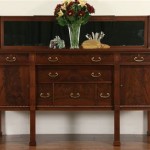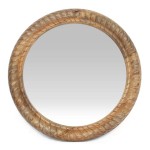French Panel Mirror: A Reflection of Elegance and History
French panel mirrors, with their timeless appeal and intricate designs, remain a sought-after decorative element for both traditional and contemporary interiors. These mirrors, imbued with a sense of history and craftsmanship, offer a touch of classic European sophistication. This article explores the defining characteristics, historical context, and practical considerations for incorporating French panel mirrors into diverse design schemes.
Key Features of French Panel Mirrors
Several key features distinguish French panel mirrors from other styles:
- Segmented Design: Composed of multiple individual mirror panels, creating a distinctive framed look.
- Ornate Frames: Often feature elaborate frames carved from wood or crafted from materials like gesso and resin, showcasing intricate details such as floral motifs, scrolls, and geometric patterns.
- Beveled Edges: The edges of the individual mirror panels are often beveled, adding depth and refracting light in a visually appealing manner.
- Antique Finishes: Many French panel mirrors boast antique finishes, ranging from subtly aged patinas to heavily distressed or gilded surfaces, enhancing their classic charm.
Historical Context and Evolution
The origins of French panel mirrors can be traced back to the 17th and 18th centuries in France, a period known for its opulent and elaborate decorative arts. During this time, mirrors became increasingly popular as symbols of wealth and status.
Early examples were often quite large and expensive, gracing the walls of grand palaces and aristocratic homes. The segmented panel design was not merely an aesthetic choice; it was also a practical necessity due to limitations in the size of glass that could be produced at the time. As glassmaking technology advanced, larger single-pane mirrors became possible, but the panel design remained a popular stylistic choice.
Variety of Styles and Sizes
French panel mirrors are available in a wide variety of styles and sizes, catering to different tastes and design needs.
- Trumeau Mirrors: Tall, narrow mirrors designed to be placed above a fireplace or console table, often incorporating a decorative panel or painting beneath the mirror section.
- Overmantle Mirrors: Specifically designed to be placed above a fireplace mantel, often featuring a horizontal orientation and a particularly grand frame.
- Arched Mirrors: Characterized by an arched top, adding a touch of architectural elegance to a space.
- Rectangular and Square Mirrors: Simple yet classic shapes that can be easily integrated into various interior styles.
Materials and Finishes
The materials and finishes used in the construction of French panel mirrors contribute significantly to their overall aesthetic.
- Wood Frames: Commonly made from hardwoods like oak, walnut, or mahogany, often carved and finished with stains, paints, or gilding.
- Gesso and Resin Frames: Offer greater flexibility in design and can replicate the intricate details of carved wood at a potentially lower cost.
- Mirror Glass: Typically high-quality mirror glass, sometimes with antique or distressed finishes to enhance the aged look.
- Metal Accents: Brass, bronze, or other metal accents can be incorporated into the frame for added ornamentation.
Placement and Design Considerations
Careful consideration of placement and surrounding décor is crucial for maximizing the impact of a French panel mirror.
- Reflecting Light: Positioning a mirror opposite a window or light source can brighten a room and create an illusion of greater space.
- Focal Point: A large, ornate French panel mirror can serve as a striking focal point in a room, drawing the eye and anchoring the design scheme.
- Complementing Existing Décor: The style and finish of the mirror should harmonize with the overall aesthetic of the room, whether it be traditional, contemporary, or eclectic.
- Scale and Proportion: Choosing a mirror that is appropriately sized for the space is essential for visual balance.
Care and Maintenance
Proper care and maintenance will ensure the longevity and beauty of a French panel mirror.
- Cleaning: Regular dusting with a soft cloth is recommended. Avoid harsh chemicals or abrasive cleaners that could damage the frame or mirror surface.
- Handling: Handle the mirror with care, supporting the frame and avoiding pressure on the glass panels.
- Environmental Factors: Avoid placing the mirror in direct sunlight or excessively humid environments, as these can damage the frame and mirror over time.
Modern Interpretations and Adaptations
While traditional French panel mirrors remain popular, modern interpretations and adaptations are also emerging, incorporating new materials, simpler designs, and updated finishes to suit contemporary tastes.
- Streamlined Frames: Modern versions may feature simpler, less ornate frames while retaining the segmented panel design.
- Mixed Materials: Combining wood with metal or other materials creates a more contemporary look.
- Unconventional Shapes: Experimenting with different shapes and configurations of the panels offers a fresh take on the classic style.
French panel mirrors offer a versatile and elegant way to enhance a variety of interior spaces. From grand traditional settings to more contemporary environments, their timeless appeal continues to resonate with those seeking a touch of classic European charm.

Antique French Credea With Brass Mirror

Antique Cream Panel Mirror Parisian Style Melea Markell

French Panel Mirror Wall Decor

French Multi Panel Mirror Design Ideas

Wilton Pale Grey Fenced Mirror One World

Splurge Vs Save Mirrors Style 02138

Small French Mirror With Églomisé Border Mi3014425 Lorfords Antiques

French Panel Mirror Decor Wall Lacquered Walls

55011ec Large French Style Beveled Glass Multi Panel Mirror

A B Home 82274 Ds Anita 36 X Inch Black Panel Mirror

